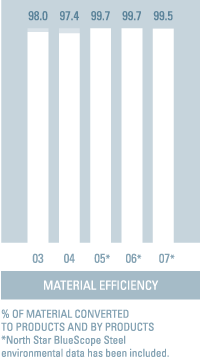Material Efficiency
|
The manufacture of iron and steel generates a number of waste materials, including slag, dusts, greases and oils, gloves and rags, and refractories.
Some of these waste streams are recycled in the steelmaking process itself, while other associated wastes, such as concrete, bulk plastic bags and timber, are recycled. By-products and wastes are recycled in a range of innovative ways. For example, slag is used in road surfaces and cement. Coke Ovens gas, when cleaned, produces by-products such as ammonium sulphate (used as a fertilizer) and chemicals used in the manufacture of plastics. Acid from the pickling process is regenerated, producing an iron oxide by-product. Applications for this by-product include the manufacture of ferric sulphate for use in water treatment, ferrite manufacturing for the electronics industry, and pigment for paint and bricks. Mill scale from the Hot Strip Mill at Western Port is also collected, dried and sold as a by-product. Innovation in reducing, re-using and recycling materials prevents thousands of tonnes of waste from going to landfill or being incinerated.
Material efficiency is a measure of how efficiently a company uses raw materials to produce its products and by-products, so as to minimise waste. The optimal material efficiency ratio is 100 per cent. In addition to reducing waste, improvements in material efficiency are often associated with cost savings and reductions in greenhouse gas emissions. Material efficiency data has been collected since FY2003. Since FY2005, with the inclusion of North Star BlueScope Steel environmental data, material efficency has been consistently above 99 per cent. |

